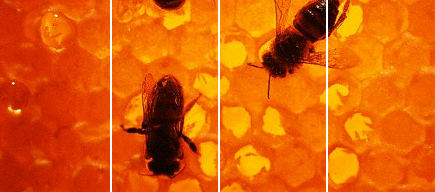 |
 |
| Honey is composed almost exclusively of sugars: these are in fact present in
percentages ranging from 95 to over 99% of dry matter. Simple sugars, fructose and glucose, form the majority (85-95%), typically with a prevalence of the former. |
Physical and nutritional properties of honey
The properties are in large part given by the above composition in sugars, especially to the high content of fructose. In a typical balanced diet, simple sugars (sweet foods in general) have little space. Even according to common opinion, sweets are believed to be harmful in a diet. Actually, sweets are not either good or bad, like any other food: the goodness depends on the amount used in relation to the needs (or problems) of the body. Furthermore, sweets are not all the same.
In the category of sweets, honey is the richest in simple sugars.
It is the only one whose features come directly from nature (plants and bees), without any artificial manipulation. The great advantage of honey is to give readily available calories, without implying any digestive process. At the same time, honey does not provide indigestible or harmful substances. From this comes its value for either healthy or ill people, or simply for those in poor state of health. |
To foster recovery of the athletes,
or of anyone doing an exercise, honey should be assumed immediately before, during and after the effort. Honey may be useful even for those doing not physical but mental efforts: it is known that the nervous system can regularly play its functions only if sufficiently fed through a constant injection of glucose in blood circulation. Far from meals the decline in the levels of blood glucose (blood sugar) may imply the loss of lucidity, attention, intellectual efficiency: a teaspoon of honey can instantly restore mental function.. |
For those in poor state of health (the elderly, and those lacking appetite) or ill, the same properties become much more valuable: when a patient for various reasons can not eat enough, a small amount of honey dissolved in a glass of water can give him the necessary strength. Honey is then a food suitable for everyone, or almost everyone. For example, when a diet is already unbalanced due to an excess of sweet food, adding honey is not recommended, while there may be advantages if a small amount of honey takes the place of the sugary food normally consumed.
Honey also is not recommended for those who have problems in the metabolism of sugar (diabetes), unless it is included in the diet under medical advice. Those having to drastically reduce the level of calories ingested (e.g. obese patients being on a diet) must carefully use honey as food: it should be remembered the substantial energy content of honey (320 kcal/100 g). |
| The main components of honey are fructose , glucose, water, and other sugars
and substances, including organic acids, minerals, enzymes, flavourings and many others. Honey is a food of high nutritional value, and easily assimilable. Glucose provides immediate energy to use, fructose is metabolised in the liver and represents a reserve of energy. One hundred grams of honey provide 320 kilo calories on average and have high sweetening power. As said before, honey is mainly composed of simple sugars (glucose and fructose in different percentages: this relationship is very important because the tendency to crystallise depends on high percentages of glucose), and is easy to digest. |
Crystallisation is a natural process mainly depending on the composition
(i.e. the ratio of glucose to fructose) and the temperature (maximum about 14C).
The higher the content of glucose, the faster the crystallisation. Low temperatures inhibit crystallisation. Honey which is just extracted has a high range of fragrances, but these tend to change over time with the occurrence of certain chemical processes accelerated by the temperature ofconservation. The main chemical parameters that are taken into account are the HMF and the Diastase enzyme. HMF or idrossimetilfurfurale is a substance virtually absent from honey just extracted and that is formed following the breakdown of sugar.This process is greatly accelerated by high temperatures; The Diastase is an enzyme naturally present in honey that progressively degrades with time and with thermal processes. HMF should not exceed 20 mg / kg. The Diastase content,however, is highly variable (depending on the quantity of natural enzymes) and generally must be greater than 8, even if there are adequate exceptions.
|
|
 |
|



